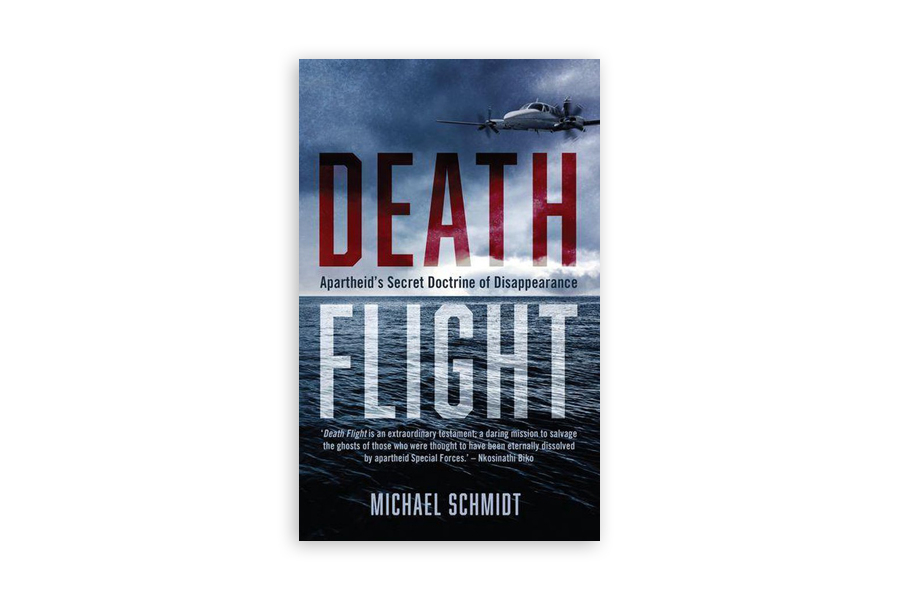Michael Schmidt’s Death Flights uncovers one of the darkest chapters of Apartheid oppression.
The fear of communism. In the seventies and eighties of last century, the elimination of ‘evil communism’ was key to the politics of dictators like Pinochet in Chile and Videla in Argentina. It had no limits, thousands of opponents of their rule disappeared completely. It is well known fact that, in spite of a lot of international protest, these generals always had a comfortable nights rest since they could count on the support of allies like the USA’s Richard Nixon, Henry Kissinger and Ronald Reagan, or Margaret Thatcher, the Iron Lady from Great Britain. All right, the UK’s war with Argentina on the Falklands (or the Malvinas) changed the subject a bit for Margaret Thatcher, but with the aid of her close friend Augusto Pinochet, her war planes could comfortably refuel in Chile.
Apartheid-South Africa: same story. The same leaders from the western world paid lip service to international protests when speaking about Apartheid, but they kept on supporting the regime of John Vorster and P.W. Botha – it was about keeping out communism, you know.
The gruesome stories of the Latin American victims, including military planes throwing thousands of bodies into the ocean -dead or alive- form one of the darkest chapters in these countries’ histories. However, less know are the death flights (plural) from South Africa who have all together dumped hundreds of drugged people, mainly members of the SWAPO, PAC and ANC liberation movements into the oceans. Most were thrown into the Atlantic, some in the Indian Ocean. A recently published book, Death Flight, by investigative journalist Michael Schmidt (Tafelberg Publishers) recalls this history, a gap in the general understanding of Apartheid-South Africa evils. Having interviewed dozens of people involved and having studied countless flight logs, Schmidt produced a very detailed and convincing reconstruction about the shocking consequences of system rightly labelled by the UN as ‘a crime against humanity’.
It all started with members of the Selous Scouts in Rhodesia. These were pretty small secret units who fought the Zimbabwean ZANU and ZAPU guerrillas. After independence in 1980, many of them resettled in South Africa. They brought with them the knowledge of how to turn a freedom fighter (sometimes with the assistance of drugs or torture) into an accomplice. They also brought knowledge about biological and chemical warfare, for instance how to throw dead poisoned bodies into the area of the enemy with the aim to contaminate that enemy.
In South Africa, newly formed units who offered their services to the Apartheid regime received approval by the highest military and governmental officials. Wouter Basson, nicknamed ‘Dr. Death’, who headed a military laboratory where staff experimented with chemical and biological warfare, joined ranks. They worked under the code names Delta 40, or Barnacle or the so called CCB – the ‘Civil Cooperation Bureau’ – or ‘Operation Dual’, a secret project to identify opponents of the regime. They targeted Namibian SWAPO fighters, or even former fighters who had been turned into accomplices (but couldn’t be trusted anymore) and had to ‘disappear’.
Read and shudder:
‘That morning [12 July 1979 (GvdB)], Major Neil Kriel received a radio message […] to pick up two packages for ‘disposal’. He knew in his gut […] what this meant: he would have to pick up two human corpses from the police and make them disappear into thin air.’
Kriel and his co-pilot Johan Theron found out that on arrival at Oshivelo, ‘the bodies turned out to be those of two PLAN [Peoples’ Liberation Army of Namibia – GvdB] guerrillas who had either been tortured to death or who had otherwise died in custody. […] Theron recalled the incident differently, claiming that the POWs were alive on delivery’. […] The two prisoners were stashed in the aircrafts aft cabin and injected in their buttocks with the anaesthetic darts.
After a refuel and a flight to a secret airfield:
‘There, the two pseudo-operators removed any clothing the two bodies had on, removed the rear door of the aircraft and hid the door and the clothing in the sand. They then took off again, heading out towards the Atlantic Ocean with the two bodies. […]. An hour later […] Kriel would have told Theron over his headset that the time had come. Holding himself steady, Theron would have unbuckled his seatbelt, and laboriously wrestled the naked men one by one out the doorway.’
With detailed descriptions, based on sources like this, the book’s author Michael Schmidt convinces the reader that South Africa also earns a place in this dirty list of death-flight-countries like Argentina, Chile and French Madagascar – where it all began. With an overload of details and (military) abbreviations the book is not always easy to read for the not-too-informed reader. But it is a necessary book for all those who may say that the Apartheid-regime, with the knowledge of today, ‘was not that bad.’ Which is, of course, nonsense. In its preface, the writer dedicates his book ‘to the families of the hundreds of men – and one woman – who were ‘disappeared’ under Operation Dual from 12 July 1979 to 12 December 1987’.
Michael Schmidt: Death Flight. Apartheid’s Secret Doctrine of Disappearance.
Tafelberg Publishers. EAN 9780624088615


